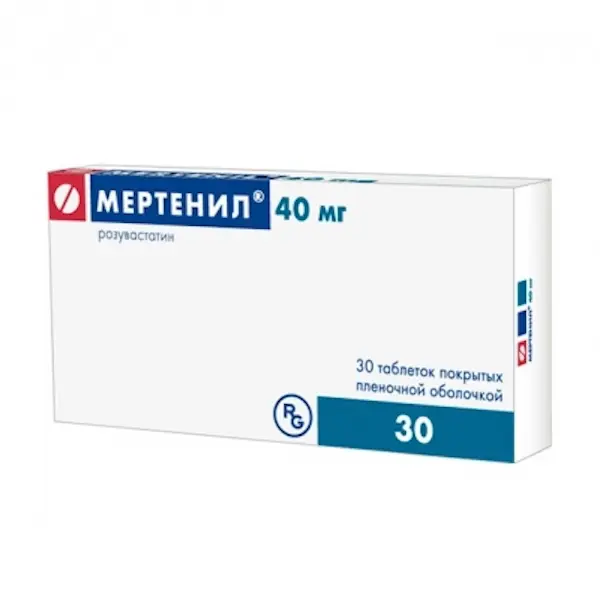Description
Mertenil Pharmacodynamics
Rosuvastatin is a selective and competitive inhibitor of HMG-CoA reductase, an enzyme that converts 3-hydroxy-3-methylglutarylcoenzyme A to mevalonate, which is a precursor of cholesterol. The main target of rosuvastatin action is the liver, where the synthesis of cholesterol (cholesterol) and catabolism of low-density lipoproteins (LDL) are performed.
Rosuvastatin increases the number of “hepatic” LDL receptors on the cell surface, increasing the capture and catabolism of LDL.
It also inhibits the synthesis of very low density lipoprotein cholesterol (VLDL) in liver cells, thereby reducing total LDL and LDL. Rosuvastatin reduces elevated LDL cholesterol (LDL-C), total cholesterol and triglycerides (TG), increases high-density lipoprotein cholesterol (HDL-C), and decreases apolipoprotein B (ApoB), non-HDL cholesterol (total cholesterol minus HDL cholesterol, HDL-C, TG-LDL-C and increases apolipoprotein A-I (ApoA-1). Rosuvastatin decreases the ratio of CH-LDL/HC-LDL, total CH/LC-LDL, non-HC-LDL/HC-LDL and ApoB/ApoA-1.
The therapeutic effect can be achieved within one week after the start of treatment, after 2 weeks 90% of the maximum possible effect is achieved. Usually the maximum possible therapeutic effect is reached after 4 weeks and maintained during further use of the drug.
Clinical efficacy
Rosuvastatin is effective in treating adult patients with hypercholesterolemia with or without symptoms of hypertriglyceridemia, regardless of their race, sex or age, as well as in treating a special category of patients, patients with diabetes or hereditary form of familial hypercholesterolemia.
Rosuvastatin is effective for the treatment of patients with type IIa and IIb hypercholesterolemia according to
Frederickson (mean baseline LDL-C levels of about 4.8 mmol/L). In 80% of patients who received 10 mg of rosuvastatin, the target values of hs-lpnp levels established by the European Society for Atherosclerosis Research (less than 3 mmol/L) were achieved.
In patients with heterozygous familial hypercholesterolemia who received rosuvastatin in doses ranging from 20 to 80 mg according to the forced dose titration scheme, all doses taken had a significant effect on changes in parameters characterizing lipid content and on achieving the goal of therapy. As a result of titrating doses up to 40 mg per day (12 weeks of therapy), LDL-C content decreased by 53%. In 33% of patients, LDL-C values were achieved (below 3 mmol/L), corresponding to the target standards of the European Society for Atherosclerosis Research guidelines.
In patients with homozygous familial hypercholesterolemia who took rosuvastatin in doses of 20 and 40 mg, the average decrease in LDL-C was 22%. In patients with hypertriglyceridemia with an initial TG concentration of 273 to 817 mg/dL who received rosuvastatin in doses ranging from 5 mg to 40 mg once daily for 6 weeks, plasma TG concentrations were significantly reduced.
Additive effect is noted in combination with fenofibrate for TG content and with nicotinic acid (more than 1 g per day) for HDL-C content.
Studies on the effect of rosuvastatin on the reduction of complications caused by lipid disorders, such as coronary artery disease, have not yet been completed.
In patients with low risk of coronary heart disease (defined as a Framingham risk of less than 10% over a period greater than 10 years), with a mean LDL-C of 4.0 mmol/L (154.5 mg/dL), rosuvastatin at a dose of 40 mg/day significantly slowed the increase in the maximum value characterizing carotid wall thickening in 12 segments compared with placebo at a rate of -0.0145 mm/yr (95% confidence interval (CI): -0.0196 to – 0.0093, at p < 0.0001). The dose of 40 mg should only be administered to patients with severe hypercholesterolemia and high cardiovascular risk.
Indications
– Hypercholesterolemia and combined (mixed) dyslipidemic conditions for reduction of elevated concentrations of total cholesterol, low-density lipoprotein cholesterol, apolipoprotein B and triglycerides in serum as an adjunct to diet therapy, when diet and other non-drug methods (e.g. exercise, body weight reduction) are insufficient.
– Familial homozygous hypercholesterolemia as an adjunct to diet therapy and other lipid-lowering therapies (e.g., LDL-apheresis) or when such therapy is not sufficiently effective.
– Hypertriglyceridemia (type IV according to Fredrickson) as an adjunct to diet.
– To slow the progression of atherosclerosis as an adjunct to the diet in patients who are indicated for therapy to reduce total cholesterol and LDL-C concentrations.
– Primary prevention of major cardiovascular complications (cardiovascular death, stroke, heart attack, unstable angina and arterial revascularization) in adult patients without clinical signs of coronary heart disease (CHD), but with increased risk of its development (age older than 50 years for men and older than 60 years for women, increased concentration of C-reactive protein (>2 mg/l) with at least one additional risk factor, such as hypertension, low concentration of HDL-C, smoking, family history of early-onset CHD).
Contraindications
– Hypersensitivity to rosuvastatin or any of the drug components;
– Liver disease in active phase, including a persistent increase in “hepatic” transaminase activity, as well as any increase in serum transaminase activity more than 3 times the upper limit of normal;
– severe renal dysfunction (CKG less than 30 ml/min);
– myopathy;
– concomitant use of cyclosporine;
– in patients predisposed to the development of myotoxic complications;
– Pregnancy and breastfeeding;
– In women of childbearing age who do not use reliable contraception;
– under 18 years of age (efficacy and safety have not been established);
– patients with hepatic impairment with a Child-Pugh score greater than 9;
– lactose intolerance, lactase deficiency or glucose-galactose malabsorption.
Dosage and administration
- Before treatment, the patient should follow a standard diet with the use of products with low cholesterol content, which must be continued during the whole period of treatment.
- Doses of the drug should be adjusted individually according to the purpose of treatment and the therapeutic response of the patient to the therapy, taking into account the current generally accepted recommendations on target lipid levels. Orally, at any time of the day, regardless of meals, do not chew or crush, swallow it whole with water.
- The recommended starting dose is 5 mg or 10 mg once daily both for patients who have not taken statins before and for patients transferred to this preparation after therapy with other HMG-CoA reductase inhibitors. When choosing the initial dose of the drug, the cholesterol level of each individual patient should be taken into account, as well as the possible risk of cardiovascular complications and the potential risk of side effects. If necessary, the dose may be adjusted after 4 weeks.
- Due to the increased risk of side effects, the dose should be increased to 40 mg only in patients with severe hypercholesterolemia and high risk of cardiovascular complications (especially in patients with hereditary hypercholesterolemia) in whom the target cholesterol level was not achieved at the 20 mg dose, and who will be under medical supervision. If a dose of 40 mg is prescribed, close medical supervision is recommended.
- Prescribing a dose of 40 mg to patients who have not previously consulted a physician is not recommended!





